Last updated on August 29, 2023
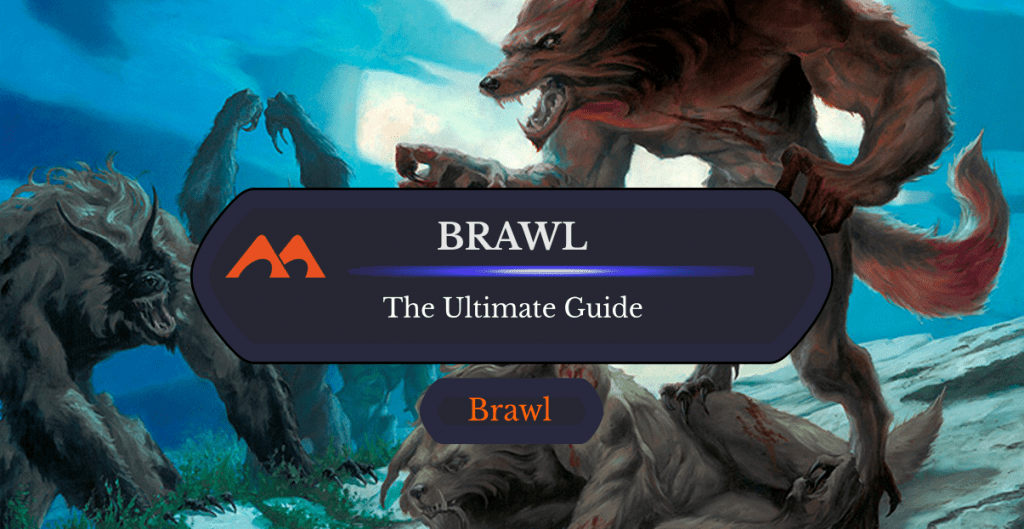
Alpha Brawl | Illustration by Randy Gallegos
There are constantly changes in sight for the ever-popular Brawl format, so it’s about time that we talked about it. We’ll provide an in-depth guide for playing MTG’s Brawl as well as some strategy talk for deck building, but don’t worry! We won’t stop there. Consider this your one-stop-shop for everything Brawl, from paper Magic to MTG Arena and back!
The MTG Brawl Format
Brawl is a game mode in MTGA that went live back in September of 2019. It's kind of a Standard-esque substitute for the famous Commander format, or at least it's very similar. Commander is a popular format among veteran MTG players, and it definitely wouldn’t be an overstatement to say that players love it.
Like Commander, Brawl is a best of one format without a sideboard.
MTG Brawl Rules
When it comes to Brawl, the rules are kind of a mishmash between the Commander format and Standard. It’s a non-competitive format that tries (and in most aspects succeeds) to be the best of both worlds. So, let’s dive into what exactly that entails, shall we?
Rules for Your Deck and Commander
First let’s get the basics out of the way: your deck will contain 60 cards with only one copy of each card except for basic lands. You’ll have one “commander” card along with 59 other cards to (assumingly) support your commander.
When it comes to decks for Brawl, you need to create an entirely different deck that follows different rules than Standard. First, you need to pick a legendary creature or planeswalker as your commander, which is placed in the “command zone” at the start of the game. This is just next to your hand in MTG Arena, as you can see on the opponent's side below:
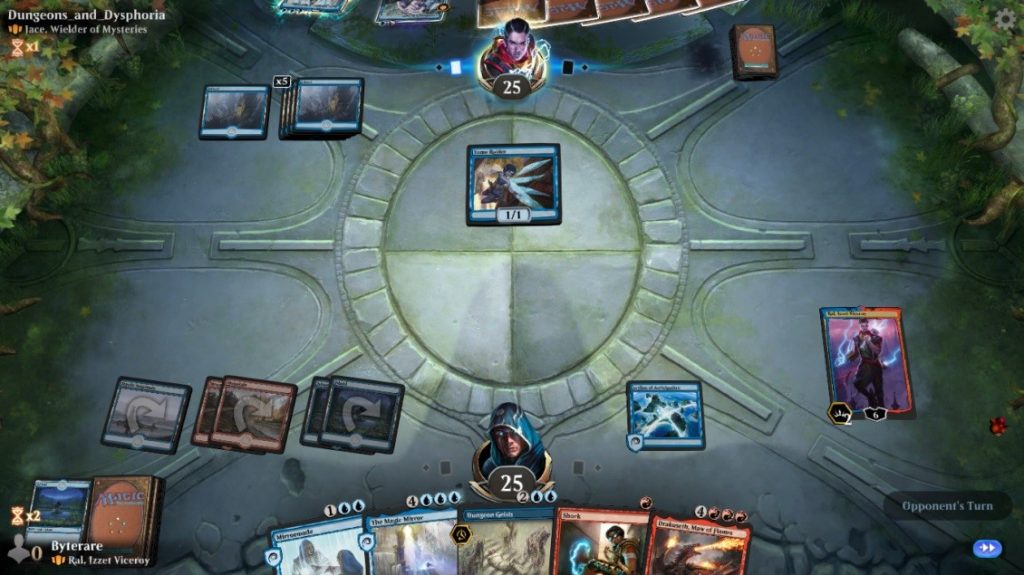
This means that, since your commander is not in your deck, you don’t need to draw it and can play it as soon as you have the mana. If your commander is removed from the battlefield (killed, exiled, destroyed, etc.) then it’s placed back in your Command Zone. Its mana cost is increased by two every time this happens, but you’re able to play it (in theory) as many times as you want.
Color Identity
The next thing to keep in mind when it comes to choosing your commander is your “color identity”, which is dictated by your commander’s mana cost and any mana symbols in its rule text. Your deck must then be built using cards that follow your color identity.
For example, if you pick Niv-Mizzet, Parun as your commander, you can only use red and/or blue cards for your deck. You don’t need to have every color from your color identity in the rest of your deck, so you can pick a multi-colored commander but build a mono deck. Don’t forget that you need to have enough mana to cast your commander if you go this route, though.
Quick note: If you select a colorless commander, you can only use unlimited copies of one type of basic land. No mixing and matching for you.
Brawl vs Commander and Standard
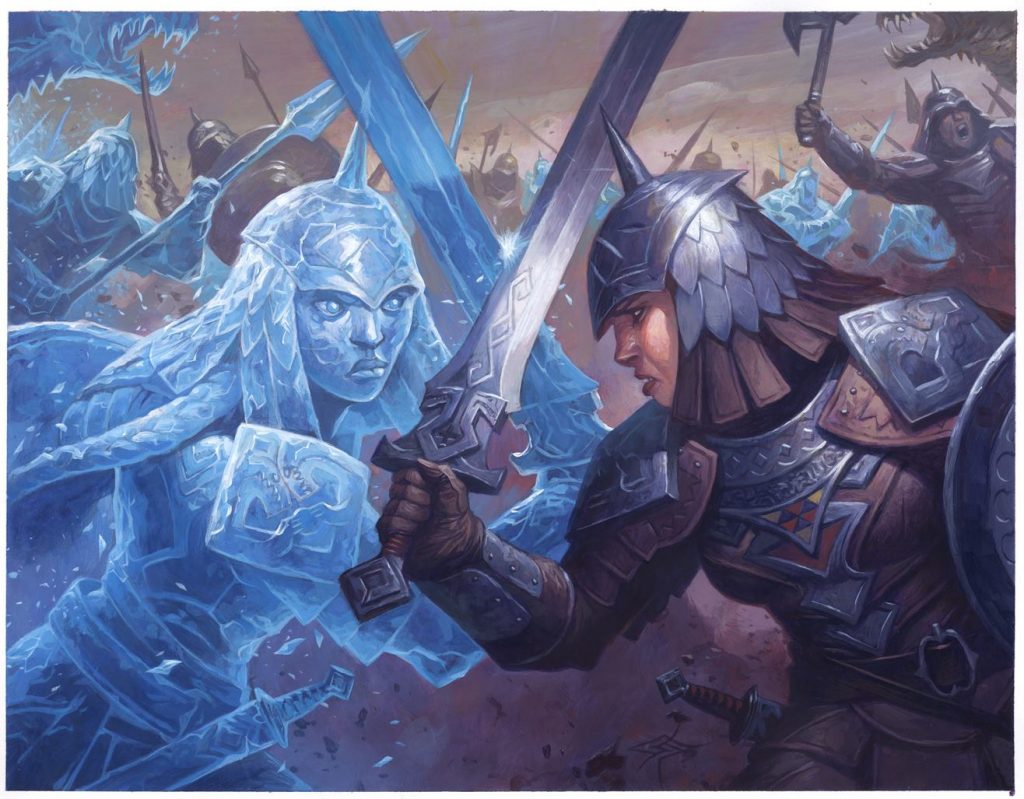
Mirror Match | Illustration by Steve Prescott
MTG's Brawl is somewhat similar to the Commander format, but there are some differences:
- Players start the game at 25 life instead of 40
- Your deck consists of 60 cards instead of 100
- The commander damage rule (if a commander deals 21 damage to the opponent its controller wins) doesn’t apply
- You get a free mulligan
- Your deck must be Standard-legal
Brawl Ban List
Brawl mode also has a separate ban list than Standard, with the following cards currently banned:
- Chalice of the Void
- Drannith Magistrate
- Lutri, the Spellchaser
- Oko, Thief of Crowns
- Omnath, Locus of Creation
- Runed Halo
- Sorcerous Spyglass
- Winota, Joiner of Forces
- Pithing Needle
The two formats are vastly different and the same cards don’t have the same impact, so having the same ban list wouldn’t make much sense. Right now, both formats do share a ban for Omnath, Locus of Creation. Probably because Omnath is just busted.
What it Means to be Singleton

Acid Rain | Illustration by Nene Thomas
Now, let’s talk about MTG Arena Singleton. Brawl is a Singleton mode, which means that you can only include one copy of each card in your deck. Duplicating them during play with spells like Quasiduplicate is free game, though.
You might already be familiar with the Singleton event that occasionally comes up, since it changes the way you formulate your strategy. Because you can only have one copy of each card in your deck, you need to pick cards that have value on their own and don’t need multiple copies to work well.
You also need to make sure that your cards have a good balance between value and synergy. Don’t worry, we’ll discuss strategies like this in just a bit.
Introducing Historic Brawl
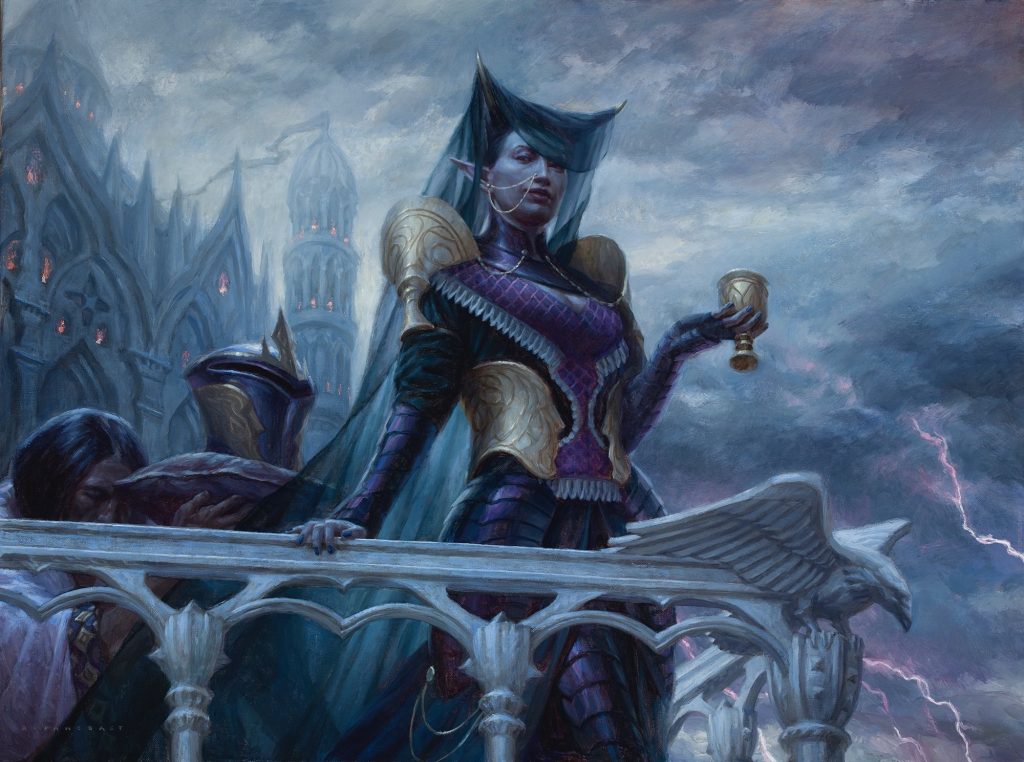
Ayara, First of Locthwain | Illustration by Ryan Pancoast
If Brawl sounds great, but you're interested in playing with a larger card pool using all of MTGA's cards including the Historic Anthology, then you're in luck. Wizards introduced this new format in March 2020. Another important difference is that, like in Commander, Historic Brawl decks need to contain 99 cards plus your commander.
Historic Brawl Ban List
Historic Brawl is its own format, and with that comes its own ban list. The following cards are banned from play in Historic Brawl:
How to Actually Play Brawl in MTG Arena
Well, our overlords have spoken, and it seems they've finally listened to the masses! As of July 1, 2020, Brawl is now a free, full-time play queue, and it's never been easier to find.
1. Click the orange “Play” button
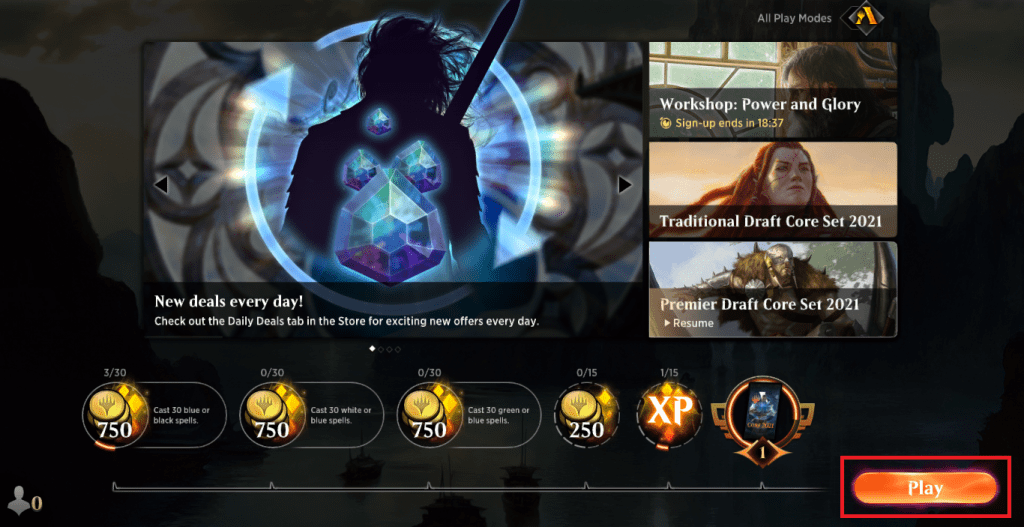
2. Click click the Commander icon to select Brawl, select your deck, and hit the “Play” button once again.
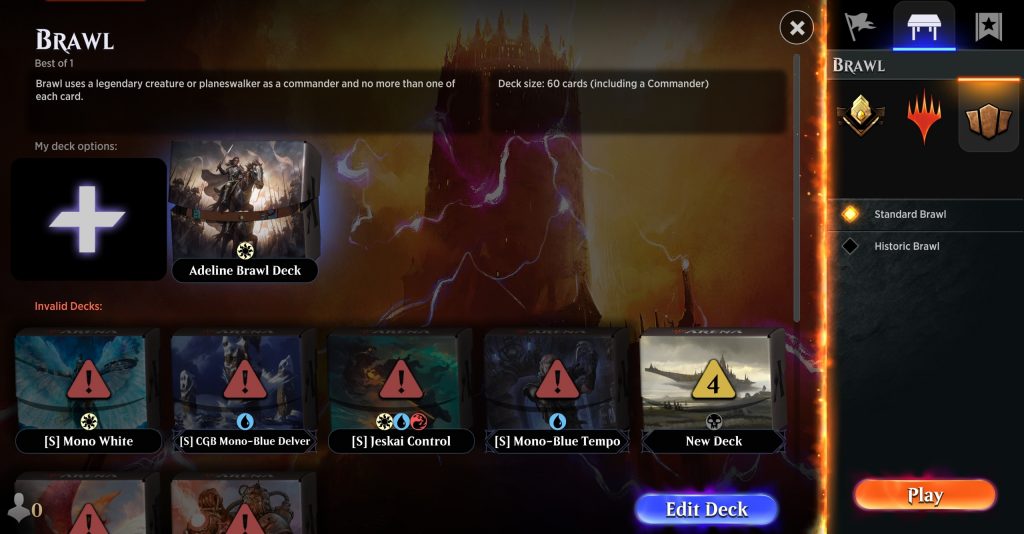
The History of Brawl in MTG Arena
Brawlers' Guildhall
The Brawlers' Guildhall was the name for the Brawl event in MTGA, and it's how you would find and play Brawl matches.
Just before WotC released the full-time Brawl queue, the Guildhall was free for a little while. To throw players a bone, Wizards decided to make the “Brawlers' Guildhall” free to enter while many were sheltering in place during the COVID-19 pandemic.
But the price of Brawl was very contentious before that, costing up to 2,000 gems or 10,000 gold for the privilege to play for a month. The only reward was a copy of the “commander-of-the-month” after your first win. Yay.
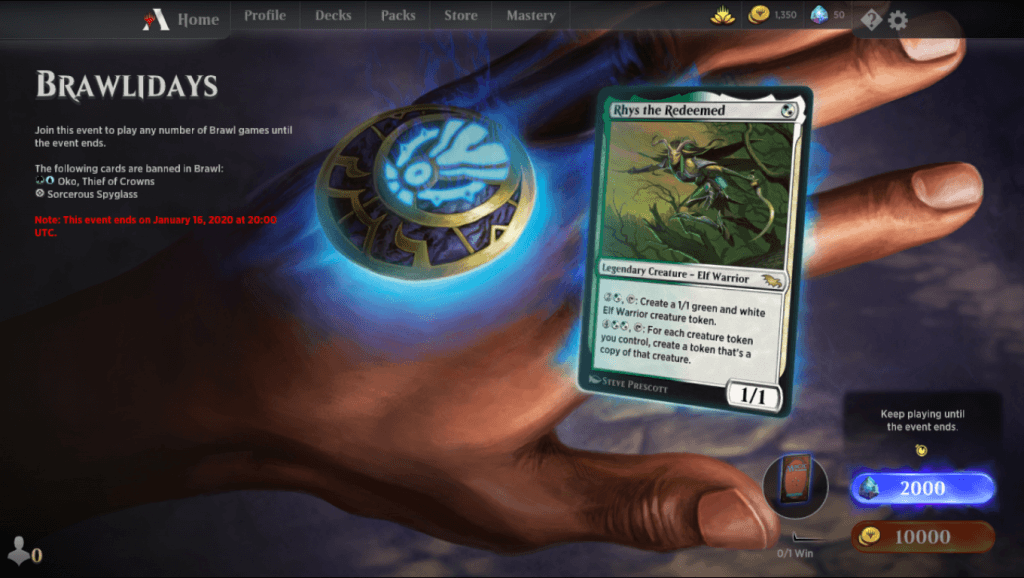
Free Brawl Matchmaking Outside MTGA
To combat the exorbitant prices—and limited availability, such as events like Brawlidays—of Brawl, third-party websites came to the rescue to help people play for free. You could get your Brawl on any time, any day.
Although you could play Brawl with players on your friends list, not everyone had that many friends on MTGA. Thankfully, ArenaBrawl.net was created to circumvent the events system by finding players to play Brawl with. Take a look.
Here's an example of how to use it:
Is Brawl Exclusive to MTG Arena?
Happy day, happy day! We’re pleased to let you know that Brawl is in fact not exclusive to MTGA!
You can play Brawl on MTG Online or even go with paper Brawl if you want. Keep in mind, though, that there aren’t many players who invest in Brawl decks so you might have more luck playing digital Brawl.
Good news is that you can play paper Brawl with two to six players, so if you like multiplayer games it might be worth haranguing your friends into playing with you.
Paper Brawl Products (Spoiler, Oops)
WotC does have some paper Brawl products if you’re gearing up to play with your friends or local Magic players. Check out Amazon for the Knight’s Charge or Faerie Schemes pre-con decks, or even get all four Throne of Eldraine pre-con Brawl decks at once.
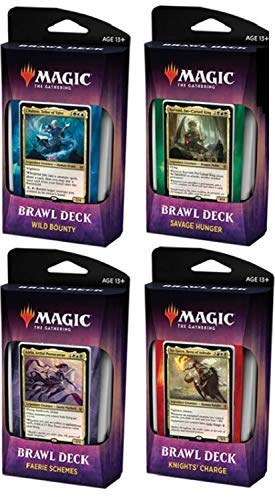
Unfortunately, if you’re looking to start an ever-flowing collection of Brawl products, that’s about the end of it. Fear not, though! You can also check out CardKingdom, MTGgoldfish, or TCGPlayer for recently published Brawl decks or individual cards if you’re itching for more.
Brawl Strategy and Deck Building
We’ve covered a lot regarding Brawl, but now it’s time to talk about strategy. There are two main things to keep in mind when it comes to Brawl decks: first, your deck needs to be Singleton in case you forgot over the last four paragraphs, and second, you need a good commander.
Selecting Single Cards for Singleton
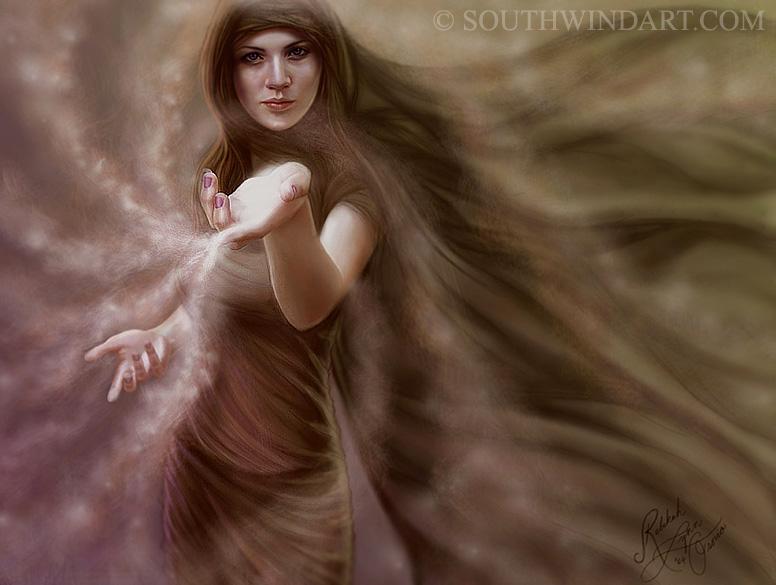
Vanish Into Memory | Illustration by Rebekah Lynn
If you are fond of playing decks that stack multiple copies of a card, then—sorry to say—you’re going to need to change your strategy. If you want to stack Ajani's Pridemate, for example, you only get one shot at it unless you have a way to bring it back from your graveyard. The same goes for stacking merfolk.
When it comes to MTG Arena Singleton decks, you need to both choose and play your cards more carefully. If your high-value card gets removed, it’s probably going to hurt more.
Most control decks are going to suffer in Singleton format. You can’t have multiple copies of the same counter-spells, so you need a variety of similar but yet still different spells. This makes it more expensive to play Brawl with a control deck, but the same idea goes for any deck that relies on multiple copies of the same cards. Insert shameless self-plug here: if you’re in need of more cards, check out our promo codes article if you haven’t already.
Choosing Your Commander
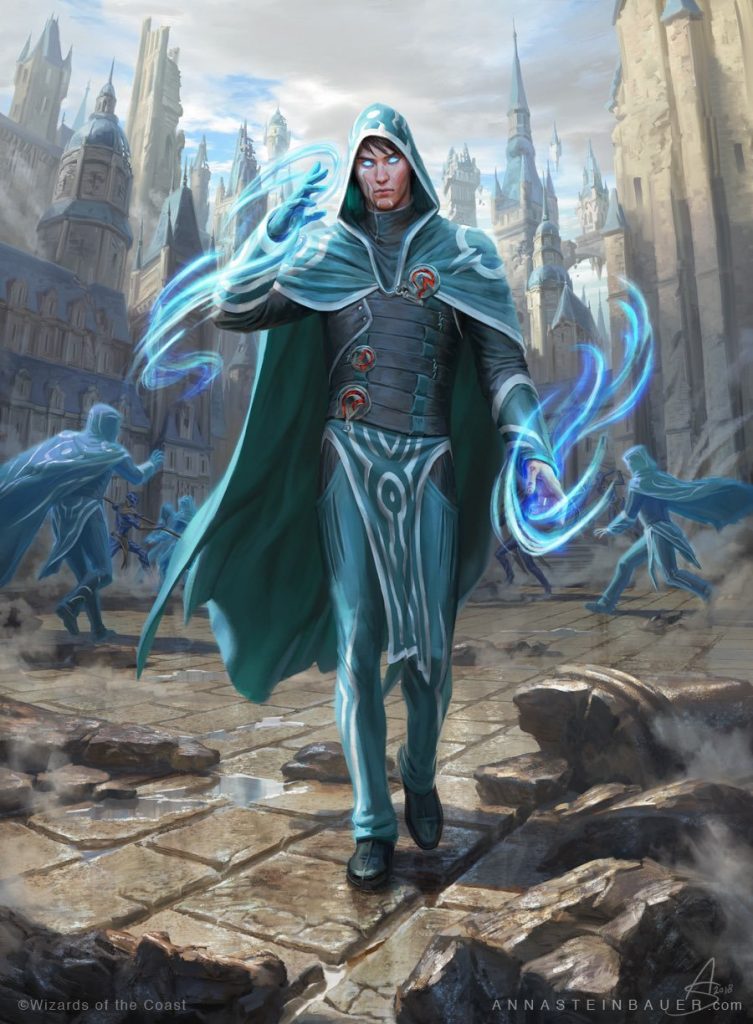
Jace, Wielder of Mysteries | Illustration by Anna Steinbauer
Choosing your commander can be tricky. It determines your color identity, it has to be a legendary creature or Planeswalker, and it needs to have synergy with the rest of your deck. If you want to get really crazy, you can even play a 5-color commander.
You need to stick with your commander's color identity when selecting the rest of your deck, and you won’t gain anything if your commander doesn’t fit since it could probably be removed easily. Even though you can play it again and again with a higher cost, this can add up quickly if your deck isn’t well suited to protect your commander.
You should pick a commander that you’ll be able to use in coordination with your deck, and vice-versa. Commanders that have a powerful impact when they enter the battlefield or that immediately affect the battlefield somehow (by proliferating or giving your creatures some bonuses) are much more desirable than those that need to wait for your next untap step.
Some Commander Commendations
Deck updates by Pedro
Etali, Primal Conqueror // Etali, Primal Sickness
Etali, Primal Conqueror is a big beast that gives you two cards when it ETBs, and you can cast them right away for free. It costs 7 mana, so you’ll usually ramp it, and since you can play green and mana rocks, that shouldn't be hard. If Etali is killed, that’s no big deal since you can cast it again and again. If it isn’t, you’ll get to transform it and kill your opponent with Etali, Primal Sickness.
Commander (1)
Etali, Primal Conqueror // Etali, Primal Sickness
Planeswalker (2)
Lukka, Bound to Ruin
Wrenn and Realmbreaker
Creature (12)
Armored Scrapgorger
Atsushi, the Blazing Sky
Cityscape Leveler
Gala Greeters
Gwenna, Eyes of Gaea
Kodama of the West Tree
Orochi Merge-Keeper
Professional Face-Breaker
Shigeki, Jukai Visionary
Sprouting Goblin
Topiary Stomper
Tyrranax Rex
Instant (5)
Big Score
Fertilid's Favor
Gaea's Gift
Tamiyo's Safekeeping
Tyvar's Stand
Sorcery (5)
Brotherhood's End
Burn Down the House
Into the Fire
Obliterating Bolt
Slimefoot's Survey
Enchantment (5)
Azusa's Many Journeys // Likeness of the Seeker
Careful Cultivation
Fable of the Mirror-Breaker // Reflection of Kiki-Jiki
Jugan Defends the Temple // Remnant of the Rising Star
Sticky Fingers
Artifact (5)
Arcane Signet
Glittering Stockpile
Reckoner Bankbuster
Relic of Legends
The Celestus
Battle (2)
Invasion of Karsus // Refraction Elemental
Invasion of Zendikar // Awakened Skyclave
Land (23)
Command Tower
Forest x11
Mountain x7
Racers' Ring
Rockfall Vale
Rugged Highlands
Wooded Ridgeline
Atraxa, Grand Unifier
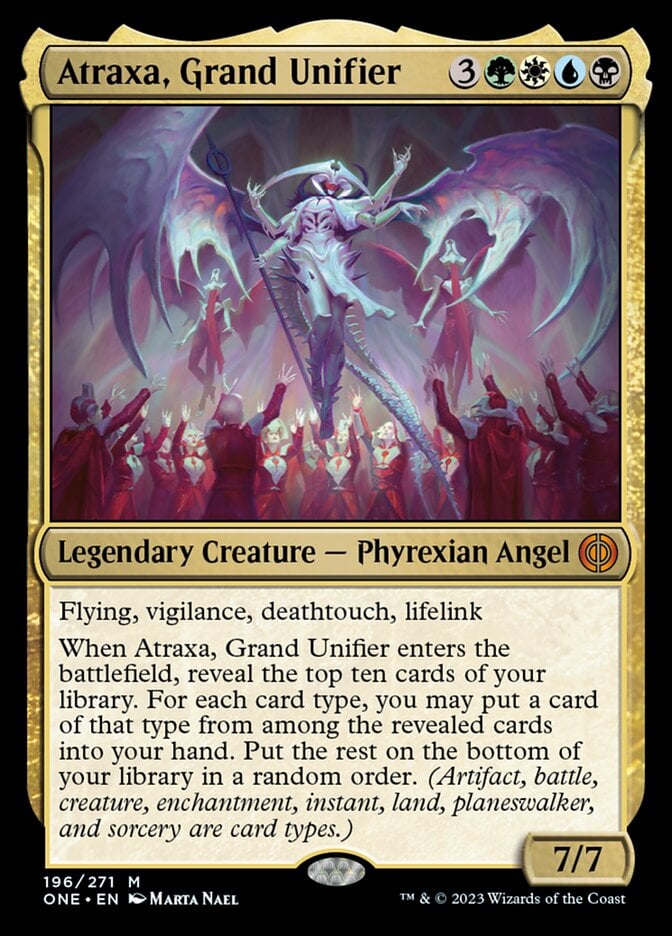
Like Etali, Primal Conqueror, casting Atraxa, Grand Unifier is already a game plan since you’ll get a massive creature that can be your win condition and a lot of card advantage. You’ll have access to four colors of mana in an Atraxa deck, and this deck is a mix of a Bant () control/ramp with added black for some removal spells.
Commander (1)
Planeswalker (4)
Kaya, Intangible Slayer
Teferi, Temporal Pilgrim
Teferi, Who Slows the Sunset
The Wandering Emperor
Creature (9)
Ambitious Farmhand // Seasoned Cathar
Armored Scrapgorger
Gwenna, Eyes of Gaea
Katilda, Dawnhart Prime
Llanowar Loamspeaker
Phyrexian Fleshgorger
Reclusive Taxidermist
Sheoldred, the Apocalypse
Topiary Stomper
Instant (8)
Boon of Safety
Cut Down
Essence Scatter
Go for the Throat
Infernal Grasp
Make Disappear
Negate
Wash Away
Sorcery (4)
Awaken the Woods
By Invitation Only
Farewell
Vanquish the Horde
Enchantment (4)
Curse of Silence
The Meathook Massacre
The Restoration of Eiganjo // Architect of Restoration
Wedding Announcement // Wedding Festivity
Artifact (5)
Arcane Signet
Reckoner Bankbuster
Relic of Legends
The Celestus
The Filigree Sylex
Land (25)
Adarkar Wastes
Brushland
Caves of Koilos
Command Tower
Deathcap Glade
Deserted Beach
Dreamroot Cascade
Evolving Wilds
Forest x2
Island x2
Llanowar Wastes
Overgrown Farmland
Plains x2
Raffine's Tower
Razorverge Thicket
Seachrome Coast
Shattered Sanctum
Shipwreck Marsh
Spara's Headquarters
Swamp x2
Yavimaya Coast
Elesh Norn, Mother of Machines

With Elesh Norn, Mother of Machines, you get the Panharmonicon effect from the command zone while also getting a massive 4/7 with vigilance that denies your opponents’ ETB effects. The challenge is to keep Elesh Norn alive because unlike Atraxa or Etali, you won’t get any benefit just for casting your commander here. But if it does survive, you’ll get to draw many cards from Inspiring Overseer while exiling double the permanents with Ossification, and so on.
Commander (1)
Elesh Norn, Mother of Machines
Planeswalker (1)
Creature (24)
Adeline, Resplendent Cathar
Ambitious Farmhand // Seasoned Cathar
Annex Sentry
Anointed Peacekeeper
Backup Agent
Basilica Shepherd
Cathar Commando
Celebrity Fencer
Elesh Norn, Mother of Machines
Extraction Specialist
Faithbound Judge // Sinner's Judgment
Inspiring Overseer
Intrepid Adversary
Loran of the Third Path
Lunarch Veteran // Luminous Phantom
Mage's Attendant
Mondrak, Glory Dominus
Raffine's Informant
Resolute Reinforcements
Rumor Gatherer
Seven-Tail Mentor
Skrelv, Defector Mite
Spirited Companion
Sungold Sentinel
Instant (3)
Destroy Evil
Fateful Absence
Union of the Third Path
Sorcery (1)
Enchantment (6)
Borrowed Time
In the Trenches
Ossification
The Restoration of Eiganjo // Architect of Restoration
Touch the Spirit Realm
Wedding Announcement // Wedding Festivity
Artifact (3)
Citizen's Crowbar
Halo Fountain
Urza's Sylex
Land (22)
Tovolar, Dire Overlord
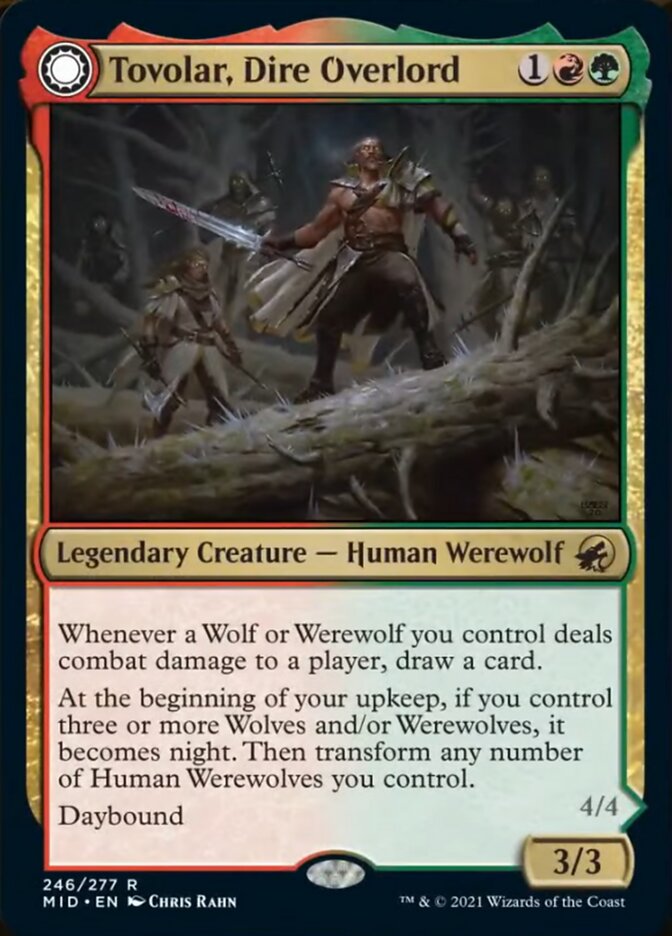
Tovolar, Dire Overlord comes early on turn 3, and it gives a massive bonus to all your wolves and werewolves. You’ll want a cheap curve and start attacking with wolves early so that when you drop your Tovolar, you’ll be able to draw 1-2 cards immediately. Since it’s a typal singleton deck, Tovolar Brawl lists are usually very similar in that they’ll play the best wolves and werewolves available, of which there are few options, as well as good fight effects available in green.
Commander (1)
Planeswalker (1)
Arlinn, the Pack's Hope // Arlinn, the Moon's Fury
Creature (22)
Ascendant Packleader
Avabruck Caretaker // Hollowhenge Huntmaster
Bounding Wolf
Flourishing Hunter
Halana and Alena, Partners
Hound Tamer // Untamed Pup
Howlpack Piper // Wildsong Howler
Hungry Ridgewolf
Ill-Tempered Loner // Howlpack Avenger
Kessig Naturalist // Lord of the Ulvenwald
Outland Liberator // Frenzied Trapbreaker
Packsong Pup
Reckless Stormseeker // Storm-Charged Slasher
Reclusive Taxidermist
Runebound Wolf
Snarling Wolf
Tovolar's Huntmaster // Tovolar's Packleader
Tovolar, Dire Overlord // Tovolar, the Midnight Scourge
Village Watch // Village Reavers
Volatile Arsonist // Dire-Strain Anarchist
Weaver of Blossoms // Blossom-Clad Werewolf
Wolfkin Outcast // Wedding Crasher
Instant (7)
Bite Down
Duel for Dominance
Gaea's Gift
Moonrager's Slash
Tail Swipe
Tamiyo's Safekeeping
Wolf Strike
Sorcery (3)
End the Festivities
Pack's Betrayal
Storm the Festival
Enchantment (2)
Land (25)
Command Tower
Forest x12
Mountain x9
Racers' Ring
Rockfall Vale
Rugged Highlands
Urza, Lord Protector
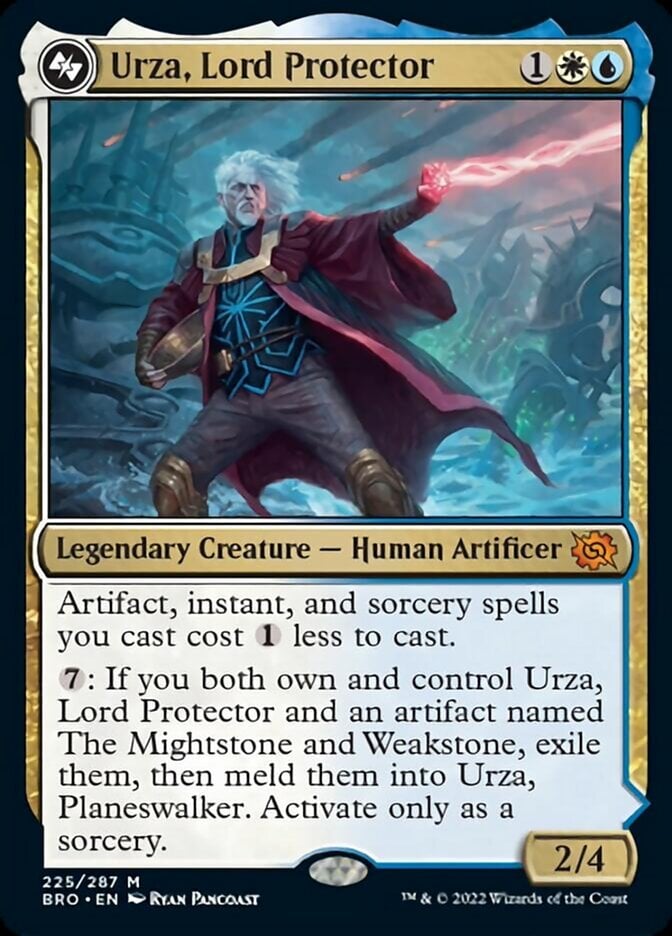
Baral, Chief of Compliance is banned in Brawl as a commander much because of the cost reduction and the loot ability. Urza, Lord Protector is similar, offering you a discount on artifacts, sorceries, and instants but a little worse. Still, if you like to play control, just countering your opponent’s spells while having a 2/4 in play is nice, and there’s the meld combo with The Mightstone and Weakstone. Getting to counter spells by paying 2 mana or a cost reduction on mana rocks and X draw spells is huge.
Commander (1)
Planeswalker (2)
Teferi, Temporal Pilgrim
The Wandering Emperor
Creature (4)
Mirrorshell Crab
Steel Seraph
The Reality Chip
Urza, Lord Protector
Instant (17)
Destroy Evil
Disdainful Stroke
Ertai's Scorn
Essence Scatter
Fading Hope
Fateful Absence
Impulse
Make Disappear
March of Otherworldly Light
Memory Deluge
Negate
Soul Partition
Syncopate
Thirst for Discovery
Urza's Rebuff
Valorous Stance
Wash Away
Sorcery (4)
Banishing Slash
Depopulate
Farewell
Silver Scrutiny
Enchantment (2)
Curse of Silence
Leyline Binding
Artifact (6)
Arcane Signet
Karn's Sylex
Portal to Phyrexia
Reckoner Bankbuster
The Celestus
The Mightstone and Weakstone
Land (25)
Adarkar Wastes
Blast Zone
Brokers Hideout
Command Tower
Deserted Beach
Eiganjo, Seat of the Empire
Field of Ruin
Hall of Tagsin
Island x6
Obscura Storefront
Otawara, Soaring City
Plains x8
Skybridge Towers
Nissa, Ascended Animist
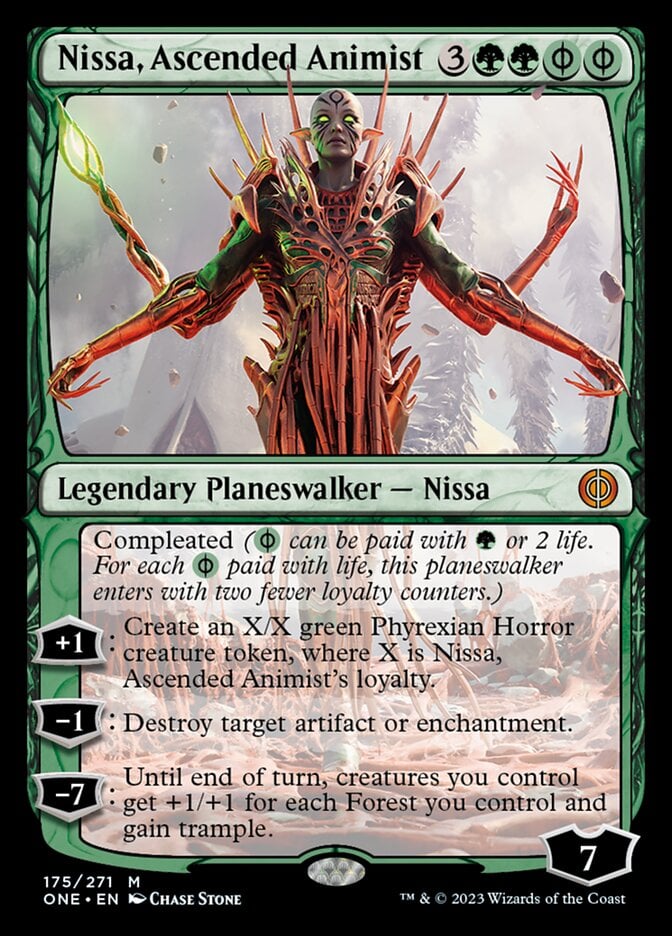
Here’s a payoff for a green ramp deck. Nissa, Ascended Animist costs 7 but can come as early as turn 5 or 4 depending on the ramp you have. After you cast Nissa, it’s time to create some tokens. You’ll probably get some value by destroying some enchantments or artifacts with the -1 ability, especially those Arcane Signets everybody plays. Nissa doesn’t have an ETB effect per se, but just casting Nissa and making a giant 6/6 or 7/7 token is a good play since you’ll recover some of the tempo lost.
Commander (1)
Planeswalker (1)
Creature (22)
Armored Scrapgorger
Blanchwood Prowler
Bloated Contaminator
Briarbridge Tracker
Citanul Stalwart
Cityscape Leveler
Contagious Vorrac
Deathbloom Gardener
Defiler of Vigor
Evolved Spinoderm
Haywire Mite
Howlpack Piper // Wildsong Howler
Llanowar Loamspeaker
Outland Liberator // Frenzied Trapbreaker
Reclusive Taxidermist
Rustvine Cultivator
Silverback Elder
Titan of Industry
Topiary Stomper
Ulvenwald Oddity // Ulvenwald Behemoth
Vorinclex // The Grand Evolution
Zopandrel, Hunger Dominus
Instant (1)
Sorcery (4)
Awaken the Woods
Bushwhack
Cartographer's Survey
Invoke the Ancients
Enchantment (4)
Azusa's Many Journeys // Likeness of the Seeker
Careful Cultivation
Jugan Defends the Temple // Remnant of the Rising Star
Tribute to the World Tree
Artifact (2)
Arcane Signet
Reckoner Bankbuster
Battle (1)
Invasion of Zendikar // Awakened Skyclave
Land (24)
Blast Zone
Forest x23
Sheoldred // The True Scriptures
Sheoldred is a mono-black control/discard deck that relies on its commander to come in, make an opponent sacrifice a creature or planeswalker. When the time’s right, flip it into The True Scriptures. You can control the board by removing key attackers or commanders, and players will wait to drop their commanders or heavy hitters if your Sheoldred is patiently waiting in the command zone. Just this threat can mess with people’s plans. Cards like The Meathook Massacre and Invoke Despair ensure that the board stays clean, and Breach the Multiverse can be a strong win condition.
Commander (1)
Sheoldred // The True Scriptures
Planeswalker (2)
Liliana of the Veil
Sorin the Mirthless
Creature (10)
Circuit Mender
Dockside Chef
Gix, Yawgmoth Praetor
Graveyard Trespasser // Graveyard Glutton
Misery's Shadow
Phyrexian Obliterator
Sheoldred // The True Scriptures
Sheoldred, the Apocalypse
Tenacious Underdog
Virus Beetle
Instant (11)
Black Sun's Twilight
Blood Pact
Cut Down
Disfigure
Go for the Throat
Hero's Downfall
Infernal Grasp
March of Wretched Sorrow
Murder
Sheoldred's Edict
Vraska's Fall
Sorcery (8)
Breach the Multiverse
Dreams of Steel and Oil
Drown in Ichor
Duress
Extract the Truth
Glistening Deluge
Invoke Despair
Soul Transfer
Enchantment (3)
Phyrexian Arena
The Cruelty of Gix
The Meathook Massacre
Artifact (1)
Battle (1)
Land (24)
Wrap Up
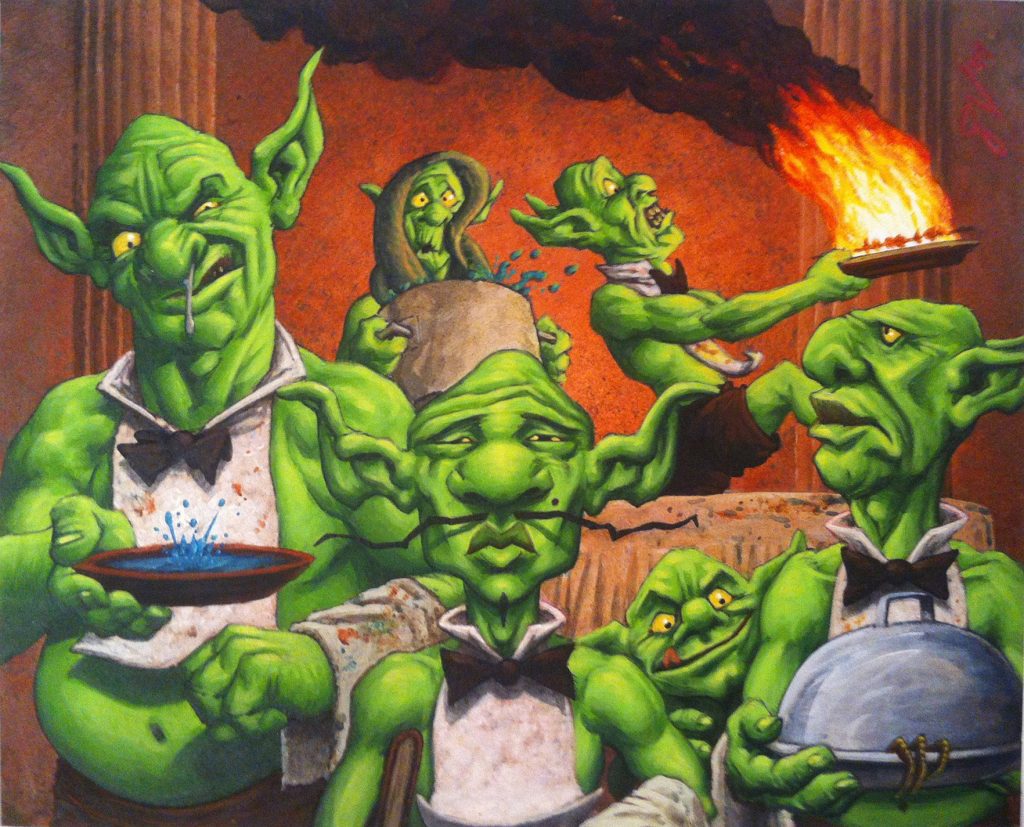
Mons's Goblin Waiters | Illustration by Pete Venters
And that just about finishes it all up. Thanks for coming, hope you had fun, don’t forget to tip your waitress!
Did you learn anything new? Got any questions, comments, or concerns for us? Let us know in the comments below. If you want to show your support, feel free to check out our Patreon or browse our excellent selection of articles on all things MTG.
Note: this post may contain affiliate links. If you use these links to make a purchase, you’ll help Draftsim continue to provide awesome free articles and apps.
Follow Draftsim for awesome articles and set updates: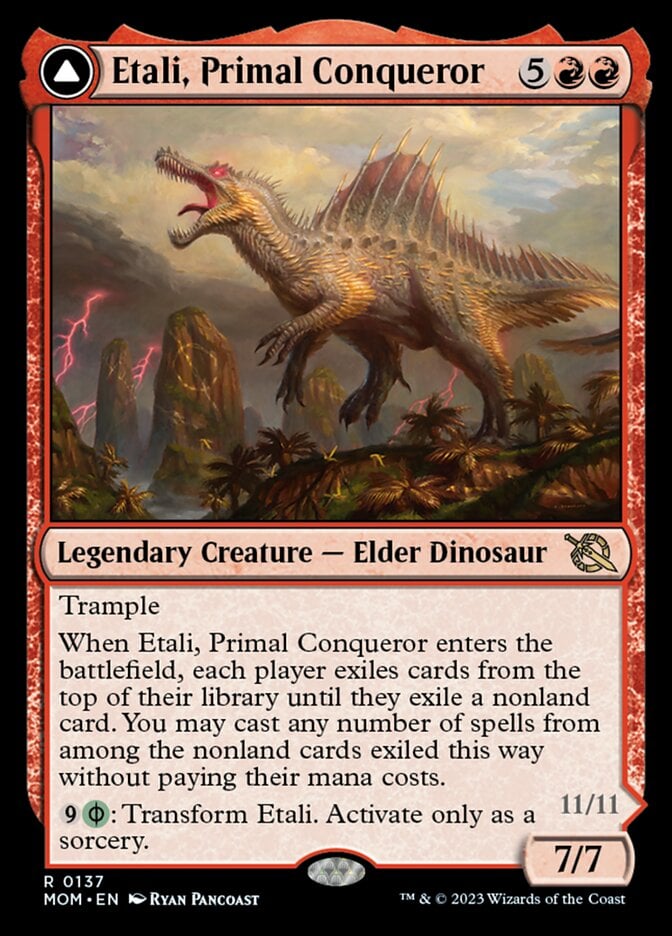

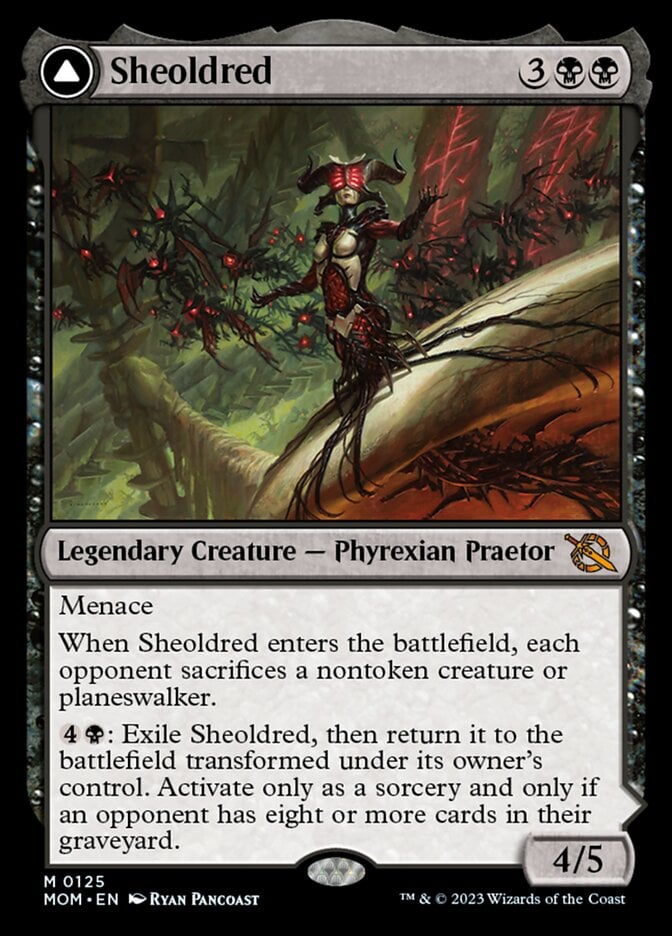

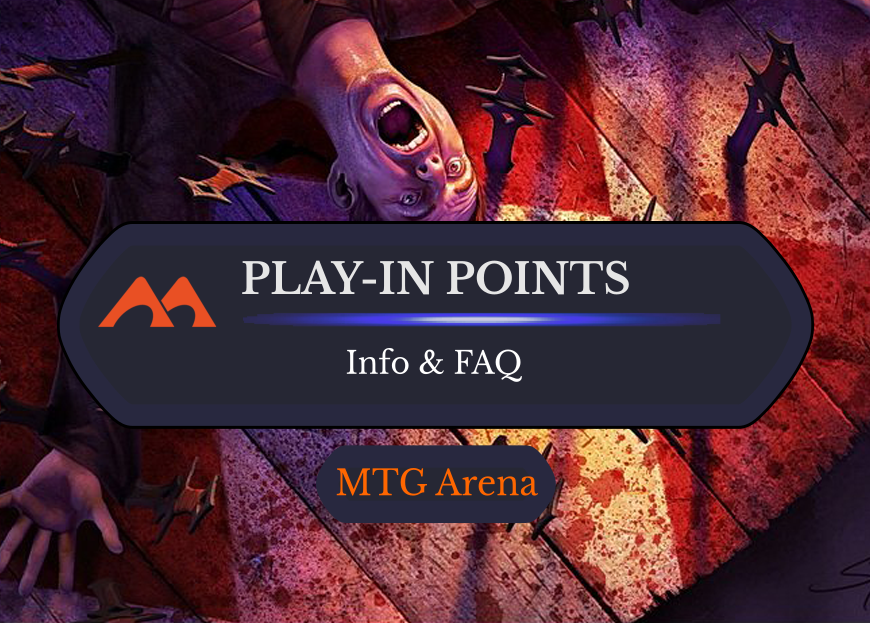
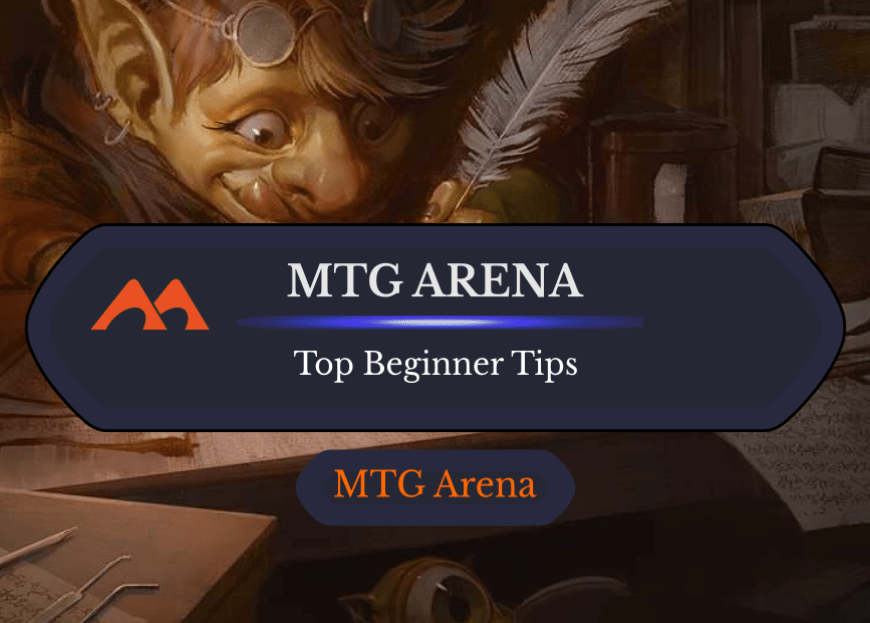
5 Comments
Thanks for the Article! Helped me a lot as I’m new into MTG Arena. Didn’t even know about the Promo Codes…
The rules text on Seven Dwarves allows you to play 7 copies even in singleton formats like Brawl or Commander.
Thanks for the correction, the article has been updated accordingly!
How do you move the commander back into the commander zone after putting it into graveyard?
Not sure exactly what you mean – this is just what happens in the rules. Is there a particular card or effect you’re referring to? Can you give a little more info?
Add Comment